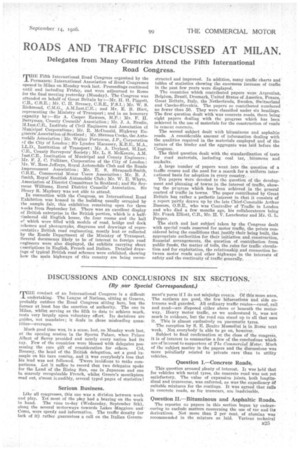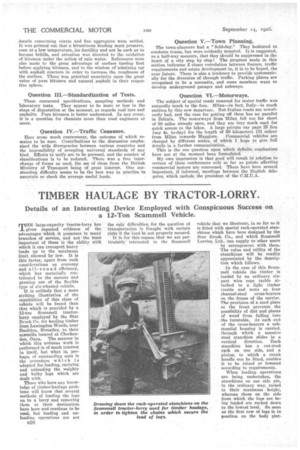DISCUSSIONS AND CONCLUSIONS IN SIX SECTIONS.
Page 43

Page 44

If you've noticed an error in this article please click here to report it so we can fix it.
(By our Special Correspondent.) TUE conduct of an international Congress is a difficult undertaking. The League of Nations, sitting at Geneva, probably outdoes the Road Congress sitting here, but the former at least has the sanction of authority. The one in Milan, whilst serving as the fifth to date to achieve much, rests very largely upon voluntary effort. Its decisions are guides, not mandates ; it deals in those misleading quan
tities—averages. • Much good time was, in a sense, lost, on Monday week last, at the opening session in the Sporza Palace, when Prince Albert of Savoy presided and nearly every nation had its ay. Few of the countries were blessed with delegates pos sessing the rare gift of consideration for others. Col. Bressey, the head of the British delegation, set a good example on his turn coming, and it was everybody's loss that his lead was not followed. .'Twere invidious to make comparisons. Let it suffice to record that two delegates spoke for the Land of the Rising Sun, one in Japanese and one in scarcely recognizable French, whilst Greece's mouthpiece read out, almost inaudibly, several typed pages of statistics!
Serious. Business.
Like all congresses, this one was a division between work and play. Yet most of the play had a bearing on the work in hand. The runs to-day (Wednesday, September 8th), along the several motorways towards Lakes -Maggiore andComo, were speedy and informative. The traffic density (or lack of it) rather guarantees a call on the Italian Govern
ment's purse if I do not misjudge events. Of this more anon. The surfaces are good, the few bifurcations and side entrances well guarded. All ordinary traffic routes—canal, rail and road—are disposed either above or beneath the motorway. Heavy motor traffic, as we understand it, was not much in evidence, but the road can stand up to all that uses it. This is almost exclusively on pneumatic tyres.
The reception by S. E. Benito Mussolini is in Rome next week. Not everybody is able to go on, however.
Subject to final confirmation at the close of the congress, it is of interest to summarize a few of the conclusions which are of interest to supporters of The Commercial Motor. Much of the subject matter in the papers and the discussions was more pe'euliarly related to private cars than to utility vehicles.
Question 1.—Concrete Roads..
This question aroused plenty of interest. It was held that for vehicles with metal tyres, the concrete road was not yet satisfactory. The value of expansion joints, both longiltudinal and transverse, was enforced, as was the expediency -Of suitable mixtures for the coatings. It was agreed that rails in concrete roads, as for tramcars, are inadvisable.
Question II.—Bituminous and Asphaltic Roads.
The reportei on papers in this section began by endeavouring to exclude matters concerning the use of tar and its derivatives. Not more than 2 per cent, of alumina was recommended in the mixture as laid. Various technical
details concerning coarse and fine aggregates were settled. It was pointed out that a bitureinous binding must preserve, even at a low temperature, its ductility and not be such as to become brittle, and attention was directed to the oxidation ef bitumen under the action of rain water. References were also made to the great advantage of surface tarring first before applying bitumen, and to the wisdom of 'admixing tar with asphalt concrete in order to increase the roughness of the surface. There' was practical unanimity upon the great value of pure bitumen and natural asphalt in their respective sphere.
Question III.—Standardization of Tests.
These concerned specifications, sampling methods and laboratory tests. They appear to be more or less in the stage of disputation at the moment, as regards coal tars and asphalts. Pure bitumen is better understood. In any event, It is a question for chemists more than road engineers or users.
Question IV.—Traffic Censuses.
Here arose much controversy, the outcome of which remains to be seen. Contributions to the discussion emphasized the wide divergencies between various countries and the impossibility of accepting universal standards of any kind. Efforts to unify are to be pursued, and the number of classifications is to be reduced. There was a free interchange of forms as used, the set of these from the British Ministry of Transport being of great interest. One outstanding difficulty seems to be the best way in practice to ascertain or check the average useful loads. Question V.—Town Planning.
The town-planners had a "field-day." They hesitated to condemn trams, but were evidently tempted. It is suggested, as a half-way measure, that they should be suppressed lathe heart of a city step by step! The progress made in this section indicates Ft. closer correlation between finance, traffic requirements and estate development in, it is to be hoped, the near future'. There is also a tendency to provide systematically for the diversion of through traffic. Parking places are recognized to be a necessity, and some members want to develop underground garages and subways.
Question VI.—Motorways.
The subject of special roads reserved for motor traffic wa's naturally much to the fore. Milan—in fact, Italy—is much smitten by this new departure. But Italian roads are notoriously bad, and the case for getting off them has no parallel in Britain. The motorways from Milan fall not far short of 50 miles already open, and they are very much used for quick access to the lakes. A large private car pays 25 lira (say 4s. to-day) for the length of 50 kilometre's (31 miles) from Milan towards Maggiore. Commercial vehicles are charged by different scales, of which I hope to give full details in a further communication.
This is the one question upon which definite conclusions have not at the moment been formulated.
My own impression is that good will result in relation to certain of these conferences only so far as points affecting commercial motors are concerned. There have been several important, if informal, meetings between the English delegates, which include the president of the C.M.U.A.




































































































